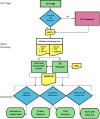Improving transitions in care for children and youth with mental health concerns: implementation and evaluation of an emergency department mental health clinical pathway
- PMID: 40165260
- PMCID: PMC11956442
- DOI: 10.1186/s12913-025-12524-z
Improving transitions in care for children and youth with mental health concerns: implementation and evaluation of an emergency department mental health clinical pathway
Abstract
Background: Emergency departments (EDs) are often the first access point for children and youth seeking mental health (MH) and addiction care. However, many EDs are unprepared to manage large volumes of pediatric MH patients. In addition, the fragmented Canadian MH system is challenged in connecting youth seen in the ED for follow-up community services. A provincial Emergency Department Mental Health Clinical Pathway (EDMHCP) for children and youth presenting to the ED with MH concerns was developed to address these challenges. The objective of the current study was to determine if EDMHCP implementation resulted in: (1) pathway use, (2) more patients discharged with MH recommendations, (3) MH service recommendations that aligned with patients' risk assessments, and (4) changes in service outcomes, including ED length of stay (LOS), revisits, and admissions/transfers.
Methods: We implemented the pathway at four ED sites from 2018 to 2019 using the Theoretical Domains Framework to develop a tailored strategy at each site. We conducted chart reviews retrospectively in 2017-2018 (pre-implementation) and prospectively in 2019-2020 (post-implementation). Non-parametric tests examined differences in service outcomes between the implementation periods.
Results: Pathway use varied widely across sites, ranging from 3.1% at site 4 to 83.0% at the lead site (site 2). More referrals to community MH agencies (p <.001) were made at discharge during post-implementation at the lead site compared to pre-implementation, and mixed results were obtained regarding whether clinicians' risk assessments aligned with MH service recommendations. LOS significantly increased at the lead site (p <.001) and non-lead sites (sites 1, 3, 4; p =.02) between pre- and post-implementation. Revisits and admissions/transfers did not change significantly at any site.
Conclusion: Implementation was partially successful at the lead site, showing high pathway use and greater referrals to community MH agencies. These findings emphasize the complexity of implementing pathways in various ED settings. Successful implementation requires integration into existing workflows.
Trial registration: ClinicalTrials.gov (NCT02590302). Registered on 29 October 2015.
Keywords: Clinical pathway; Emergency department; Implementation; Mental health; Pediatric.
© 2025. The Author(s).
Conflict of interest statement
Declarations. Ethics approval and consent to participate: This study was approved by the Research Ethics Board at the Children’s Hospital of Eastern Ontario (REB #15/146X). Prior to the implementation of the EDMHCP, ethics approval was also obtained from the Ethics Committees at the Cornwall Community Hospital and the Winchester District Memorial Hospital, as well as the Pembroke Regional Hospital Research Ethics Board. As this study used secondary data from a retrospective chart review, the Research Ethics Board at the Children’s Hospital of Eastern Ontario determined that obtaining informed consent from all participants not necessary or feasible. The study was conducted according to the guidelines of the Declaration of Helsinki. Consent for publication: Not applicable. Competing interests: The authors declare no competing interests.
Figures


Similar articles
-
Improving mental health care transitions for children and youth: a protocol to implement and evaluate an emergency department clinical pathway.Implement Sci. 2016 Jul 7;11(1):90. doi: 10.1186/s13012-016-0456-9. Implement Sci. 2016. PMID: 27389410 Free PMC article.
-
Pediatric emergency mental health presentations during early COVID-19: Comparing virtual and in-person presentations.Clin Child Psychol Psychiatry. 2025 Jan;30(1):79-94. doi: 10.1177/13591045241286562. Epub 2024 Oct 17. Clin Child Psychol Psychiatry. 2025. PMID: 39419633
-
Use of a Dedicated, Non-Physician-led Mental Health Team to Reduce Pediatric Emergency Department Lengths of Stay.Acad Emerg Med. 2016 Apr;23(4):440-7. doi: 10.1111/acem.12908. Epub 2016 Mar 22. Acad Emerg Med. 2016. PMID: 26806468
-
An Emergency Department Clinical Pathway for Children and Youth with Mental Health Conditions.Child Adolesc Psychiatr Clin N Am. 2018 Jul;27(3):413-425. doi: 10.1016/j.chc.2018.02.005. Child Adolesc Psychiatr Clin N Am. 2018. PMID: 29933791 Review.
-
Evaluating mental health decision units in acute care pathways (DECISION): a quasi-experimental, qualitative and health economic evaluation.Health Soc Care Deliv Res. 2023 Dec;11(25):1-221. doi: 10.3310/PBSM2274. Health Soc Care Deliv Res. 2023. PMID: 38149657
References
-
- McCabe EM, Lightbody TK, Mummery C, Coloumbe A, GermAnn K, Lent B, Black L, Graham KE, Gross DP, Miciak M. Implementing a clinical pathway for paediatric mental health care in the emergency department. Can J Community Mental Health. 2020;38(4):1–8. 10.7870/CJCMH-2019-015.
-
- Chiu M, Gatov E, Fung K, Kurdyak P, Guttmann A. Deconstructing the rise in mental health-related ED visits among children and youth in Ontario. Can Health Aff (Millwood). 2020;39(10):1728–36. 10.1377/hlthaff.2020.00232. - PubMed
-
- Mental Health and Addictions Program Framework Research Team. Mental Health and Addictions System Performance in Ontario: 2021 Scorecard. Toronto: ICES; 2021. https://www.ices.on.ca/publications/research-reports/mental-health-and-a....
-
- Leon SL, Cloutier P, Polihronis C, Zemek R, Newton AS, Gray C, Cappelli M. Child and adolescent mental health repeat visits to the emergency department: a systematic review. Hosp Pediatr. 2017;7(3):177–86. 10.1542/HPEDS.2016-0120. - PubMed
Publication types
MeSH terms
Associated data
Grants and funding
LinkOut - more resources
Full Text Sources
Medical

